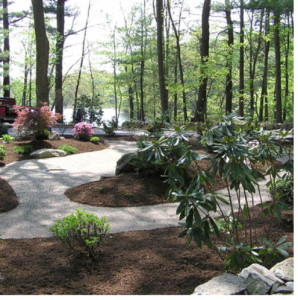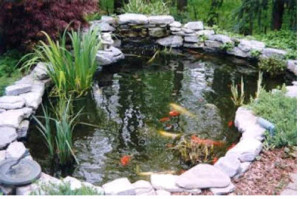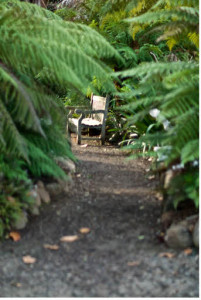This article first appeared in South Carolina Midlands Master Gardener’s magazine – “And Sow Forth” June Issue.
Poem for Ron Cowart
Walk into My Garden
Walk into my garden and meander round the path;
Hang your worries on the bottle tree.
Carolina wren songs provide the symphony,
As you wander along with me.
We’ll lose our words in the trickling waters,
While sitting upon a boulder beside the koi pond.
Sweet perfume of roses invites us to travel round a bend,
Touch only the velvet petals; the thorns are not fun!
Nature’s blessings unfold before our eyes;
These blooms are for a season.
Each life is like one flower that never blooms again;
Walk upon life’s paths with wise reason.
When our stroll has ended at the same spot we began,
Wave good-bye to pink poppies swaying in the breeze.
We are the same but different somehow,
By sharing memories of paths like these.
Ruby Haydock DeLoach
A well planned walkway through the backyard garden should produce one of the greatest influences on the visitor’s experience. As we know, walkways are a ground plane landscape element. Strolling on a walkway through the garden should be a pleasant experience, like savoring a scrumptious meal, a little bite here and a little bite there. Nobody should be in a hurry. As the saying goes, “Take time to smell the roses”.
There are three categories of walkways. The use of the walkway determines the ground plane material, soft or hard. Soft materials include thick layers of bark, pine straw and aggregate gravel. These materials should be contained with an edge restraint. Hard materials include concrete, Brick pavers, concrete pavers, flagstone and wood for boardwalks.
The three categories are primary, secondary and tertiary. Primary walkways are those walkways that are used for moderate to heavy pedestrian traffic linking to major landscape elements; swimming pool, tool building, parking pad to back residual entrance etc. Primary walkways are constructed of cement, brick pavers, concrete pavers and flagstone. They should be 54 inches (four and a half feet) wide to allow 2 people to walk side by side. Primary walkways may border flower and shrub beds, however, they are not constructed primarily for this purpose.
Secondary sidewalks are usually constructed with pea size to ¾ inch angular granite with fines. It is not recommended to use round river stone, because of the ball bearing effect, this stone will not pack, and is easily scattered. An edge restraint such as black plastic with a roll on the top edge, treated 1 inch by 6 inch boards or steel bed divider should be used to keep the gravel in place. Concrete stepping stones or 24 to 28 inch diameter flagstone stepping stones may be nestled into the granite gravel. A bark mulch material can be substituted for the gravel.
Secondary walkways is the second category, and is the main emphasis of this article. Secondary walkways can be constructed in full sunlight or passing shade. I have observed that there is more maintenance in full light because of the weed pressure. There are several reasons for this walkway (1) relative inexpensive construction materials, (2) easy to install, (3) rainfall and supplement irrigation is allowed to wet the underlying soil, and (4) may be used to link and border landscape elements such as koi ponds, annual and perennial flower beds and secluded resting areas. These walkways are known as the “side streets of the garden.
 Tertiary walkways are natural paths that enable the gardener to access shrub and flower beds for maintenance. These walkways should be unnoticed by the visitor. These are the “back alley roads” of the garden.
Tertiary walkways are natural paths that enable the gardener to access shrub and flower beds for maintenance. These walkways should be unnoticed by the visitor. These are the “back alley roads” of the garden.
A secondary gravel walkway may begin at a deck or patio and lead to a nearby koi pond located to one side of the backyard. Most koi ponds are kidney shaped, therefore the walkway should border the concave side of the pond and widen at this point to slow the visitor’s pace and enjoy the scene. The back convex side should be a part of the mulched perimeter area of the back yard. This prevents the koi pond from being over powering. Remember, koi ponds should be located relatively close to a deck or patio for one to see and hear the waterfall sounds, and located away from beneath trees with heavy leaf fall.
The walkway may leave the koi pond and lead the visitor deeper into the backyard, following a curvilinear line separating the turf area from the rear landscape bed. This area is suited for a walkway as a result of occasional turf grass thinning-out caused by shade and tree root competition. Annual and perennial colors may be located on both sides of the walkway on this line with the addition of soil amendments. This color can be viewed from the deck and/or patio and be enjoyed by the visitor while walking through this area with shorter flowering plants on the turf grass side and taller flowering plants on the landscape bed side. The walkway edge restraints will serve as a border for these flowering annuals and perennials.
The gravel walkway may turn inward into the rear landscape bed and in a curvilinear stroke lead to a turn in the walkway to a widened area with a comfortable bench, inviting the visitor to rest and “abide awhile” The ends and back of the setting area should be partially enclosed with screening type shrubs to insure privacy for restful thoughts and meditation.
The rest of the visitor’s stroll is filled with things of interest along the way at every turn, and at last the journey ends where it begin, —– the koi pond.
We begin where we end, and all between is where we’ve been.
This article was written by Ron Cowart, Cowart Landscape Consulting. Ron specializes in solving turfgrass problems. All turf samples are sent to Clemson University for analysis. A complete summarized report is written based upon the cause of the disease or disorder and the recommended treatment is included. Call Ron at (803) 513-4242 for a yard visit.





